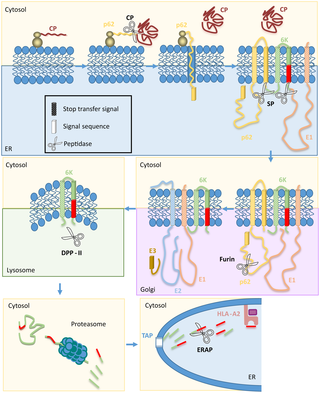PLOS Neglected Tropical Diseases ( IF 3.4 ) Pub Date : 2017-10-30 , DOI: 10.1371/journal.pntd.0006036 Elena Lorente 1 , Alejandro Barriga 1 , Juan García-Arriaza 2 , François A Lemonnier 3 , Mariano Esteban 2 , Daniel López 1

|
Background
The adaptive cytotoxic T lymphocyte (CTL)-mediated immune response is critical for clearance of many viral infections. These CTL recognize naturally processed short viral antigenic peptides bound to human leukocyte antigen (HLA) class I molecules on the surface of infected cells. This specific recognition allows the killing of virus-infected cells. The T cell immune T cell response to Chikungunya virus (CHIKV), a mosquito-borne Alphavirus of the Togaviridae family responsible for severe musculoskeletal disorders, has not been fully defined; nonetheless, the importance of HLA class I-restricted immune response in this virus has been hypothesized.
Methodology/Principal findings
By infection of HLA-A*0201-transgenic mice with a recombinant vaccinia virus that encodes the CHIKV structural polyprotein (rVACV-CHIKV), we identified the first human T cell epitopes from CHIKV. These three novel 6K transmembrane protein-derived epitopes are presented by the common HLA class I molecule, HLA-A*0201. One of these epitopes is processed and presented via a complex pathway that involves proteases from different subcellular locations. Specific chemical inhibitors blocked these events in rVACV-CHIKV-infected cells.
Conclusions/Significance
Our data have implications not only for the identification of novel Alphavirus and Togaviridae antiviral CTL responses, but also for analyzing presentation of antigen from viruses of different families and orders that use host proteinases to generate their mature envelope proteins.
中文翻译:

基孔肯雅热 6K 蛋白 HLA-A*0201 限制性表位的复杂抗原呈递途径
背景
适应性细胞毒性 T 淋巴细胞 (CTL) 介导的免疫反应对于清除许多病毒感染至关重要。这些 CTL 识别与受感染细胞表面的人类白细胞抗原 (HLA) I 类分子结合的自然加工的短病毒抗原肽。这种特异性识别可以杀死病毒感染的细胞。 T 细胞免疫 T 细胞对基孔肯雅病毒 (CHIKV) 的反应尚未完全明确,基孔肯雅病毒是一种由蚊子传播的披膜病毒科甲病毒,可导致严重的肌肉骨骼疾病;尽管如此,该病毒中 HLA I 类限制性免疫反应的重要性已被假设。
方法/主要发现
通过用编码 CHIKV 结构多蛋白 (rVACV-CHIKV) 的重组痘苗病毒感染 HLA-A*0201 转基因小鼠,我们鉴定了第一个来自 CHIKV 的人类 T 细胞表位。这三种新型 6K 跨膜蛋白衍生表位由常见的 HLA I 类分子 HLA-A*0201 呈现。这些表位之一通过复杂的途径进行加工和呈递,该途径涉及来自不同亚细胞位置的蛋白酶。特定的化学抑制剂阻止了 rVACV-CHIKV 感染细胞中的这些事件。
结论/意义
我们的数据不仅对鉴定新型甲病毒和披膜病毒科抗病毒 CTL 反应具有意义,而且对分析不同科和目病毒的抗原呈递,这些病毒使用宿主蛋白酶产生成熟的包膜蛋白。









































 京公网安备 11010802027423号
京公网安备 11010802027423号